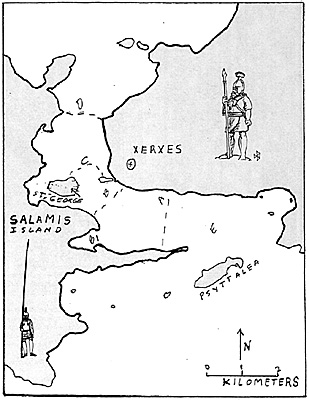Assuming both sides are being programmed, follow these steps:
- Dice for Persian fleet size.
Select Persian approach to the straits.
Dice for Greek fleet size.
Select Greek position in the strait.
Write orders for each fleet, Persian first.
Move the two fleets simultaneously. As specified in rules.
I have provided a briefing on the ships used in the battle and some ideas about modeling them. These are just before the rules.
Fleet Size
A survey of expert opinion on fleet sizes comes up with a wide variety of estimates. Roll a single die (D6). Whatever number you get, there is an expert who thinks the Persian fleet was that size.
Persian Fleet Size:
- 400
600
800
1000
1200
1300
Greek fleet size varies less. Again roll 1D6:
- 250
300
306
310
350
380
You may simply decide to establish a ratio between Persian and Greek fleets. The experts offer us three Persian to one Greek, but there is one who has the Greeks facing at least two to one odds. In selecting the number of model ships you use, remember the Persian fleet was much too big to conveniently fit in the straits.
The Persian Approach
The Persian fleet was trying to keep the Greeks from escaping. They blocked both exits from Salamis. They sent an Egyptian fleet (200?) to block the northern strait. We hear no more about them. The main Persian fleet expected to fight about point E on the "Straits of Salamis 480 B.C." map. They stationed soldiers (about 400?) on the island Psyttalaia (or Lipsokoutal) to kill Greeks washed up from the straits. They already held the Greek mainland, and their king, Xerxes, was observing the battle from a eat on high ground. Put the numbers on paper and draw them out of a box. Or if you want to be really authentic, scratch the number on a shard of pottery and draw it out of the pottery jar.
Salamis – 480 B.C. This map shows the big picture. I spent years before I saw a map showing the island. The Athenian population is on salamis. The Greek fleet is in the ports on the island. The Persians control the mainland, and their fleet has closed both exits from the straits. The main Persian fleet is at the south exit. A smaller Egyptian fleet guards the other. Xerxes has a seat overlooking the presumed battle site.
Both maps are attempts to show the ancient coastline. Some modern islands are shown here as peninsulas. The dotted lines and letters A to E mark possible positions for the Greek fleet.
The main Persian fleet advances along the coast and into the straits passing along the coast and into the straits passing to the right of Psyttalaia and a smaller part of the fleet passes to the left of Psyttalaia and links up. They form a line abreast as they enter the strait.
The Persian fleet advances in a line ahead two or three ships wide past Psyttalaia and perpendicular to the mainland coast. When enough ships have passed the island, they execute a turn to their left flank and advance in line abreast into the strait. Following ships in the Persian fleet repeat the maneuver. Thus a Persian fleet in line ahead becomes a fleet with a broad (9 ships?) front, several ranks deep. (I personally can't see this working, but it was suggested by an expert with an army background.)
The Persians advance along the coast, form into a line abreast and move to the right past Psyttalaia into the strait.
This is a wild card. Nobody claims this happened. Have the Egyptians come into the straits and hit the Greeks in the rear. Note: the Greeks may have anticipated such an attack. They detached a force toward the north strait. Exactly what that detached force did in the battle is unclear.
The Greek Position
The Greeks were defending and presumably got to select the line they would defend. They would be in line one move back from their chosen point of contact. They would then move forward to meet the Persians. The Athenians were on the right. The map "Straits of Salamis 480 B.C." shows the Greek choices. Put the letters on a paper and draw them out of a box.
Right at the entrance of the Strait. This position should take advantage of Persian confusion as they first enter narrow waters.
Just past the bay of the town of Salamis. This position allows part of the Greek fleet to hit the Persian flank.
Just past the island of Pharmkoussas (modern St. George) and coming out of the most narrow passage in the straits. The waters on the outside of the islands were too shallow for ships. This position allows the Greeks to attack the front and both flanks of the Persian fleet as they emerge into more open water.
The last narrow place before the Bay of Eleusis. Looks too far in to me, but who knows?
This is not an option if trying to recreate the historical battle, but you could have the Greeks try to fight a breakout battle beyond A. This is the battle the Persians expected.
Additional Scenarios:
There are a couple of scenarios that you may want to spin off. You could play a naval battle in the north strait. This would be between the Egyptians and a detachment of Greeks. There is one part of the historical Battle of Salamis not covered in my rules. The Greeks ferried troops to the island of Psyttalaia and wiped out the Persians there. Your challenge is to design a combined operations game.

More Salamis
Back to Table of Contents -- Lone Warrior #129
Back to Lone Warrior List of Issues
Back to MagWeb Magazine List
© Copyright 2000 by Solo Wargamers Association.
This article appears in MagWeb (Magazine Web) on the Internet World Wide Web.
Other military history articles and gaming articles are available at http://www.magweb.com
